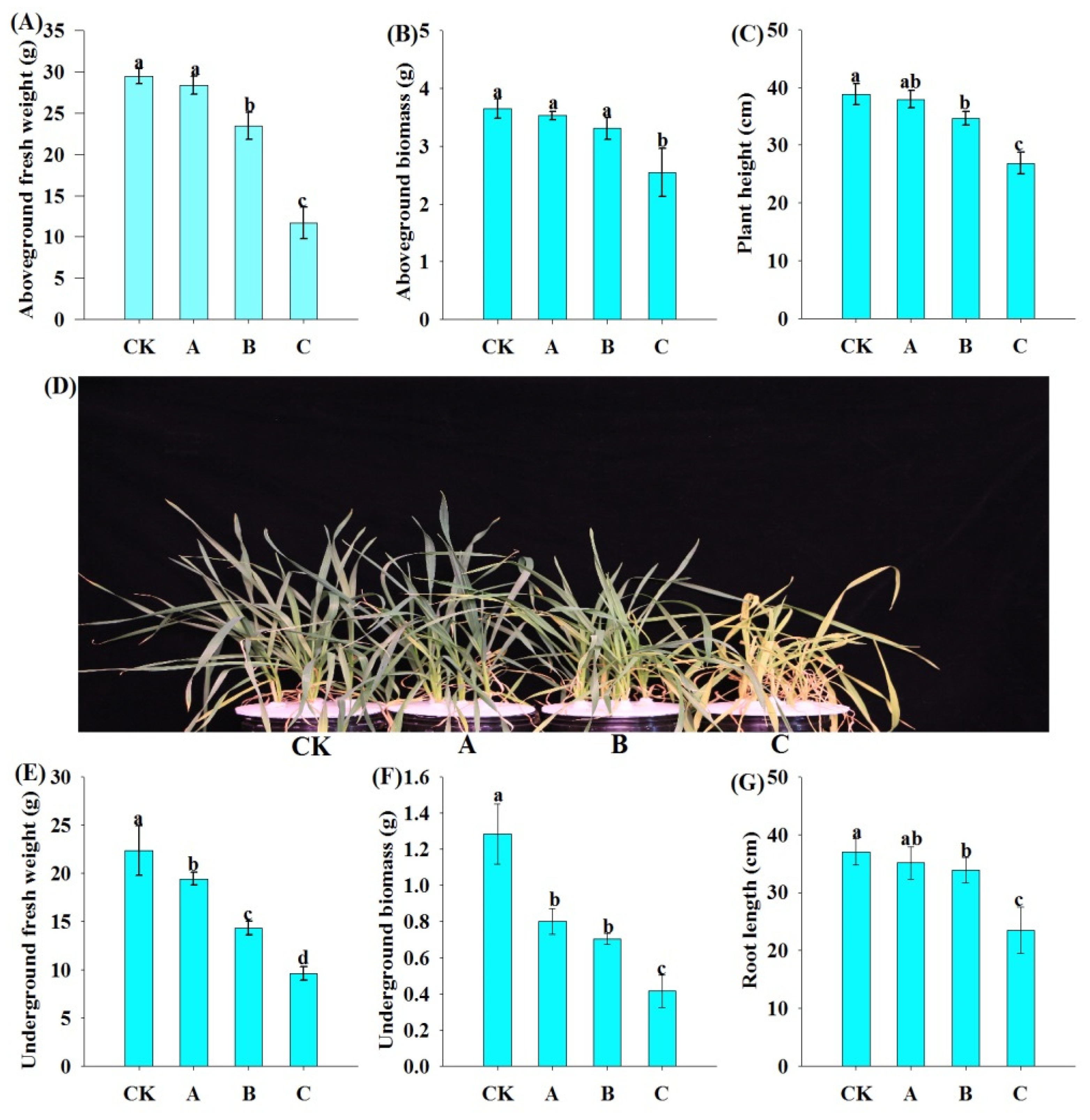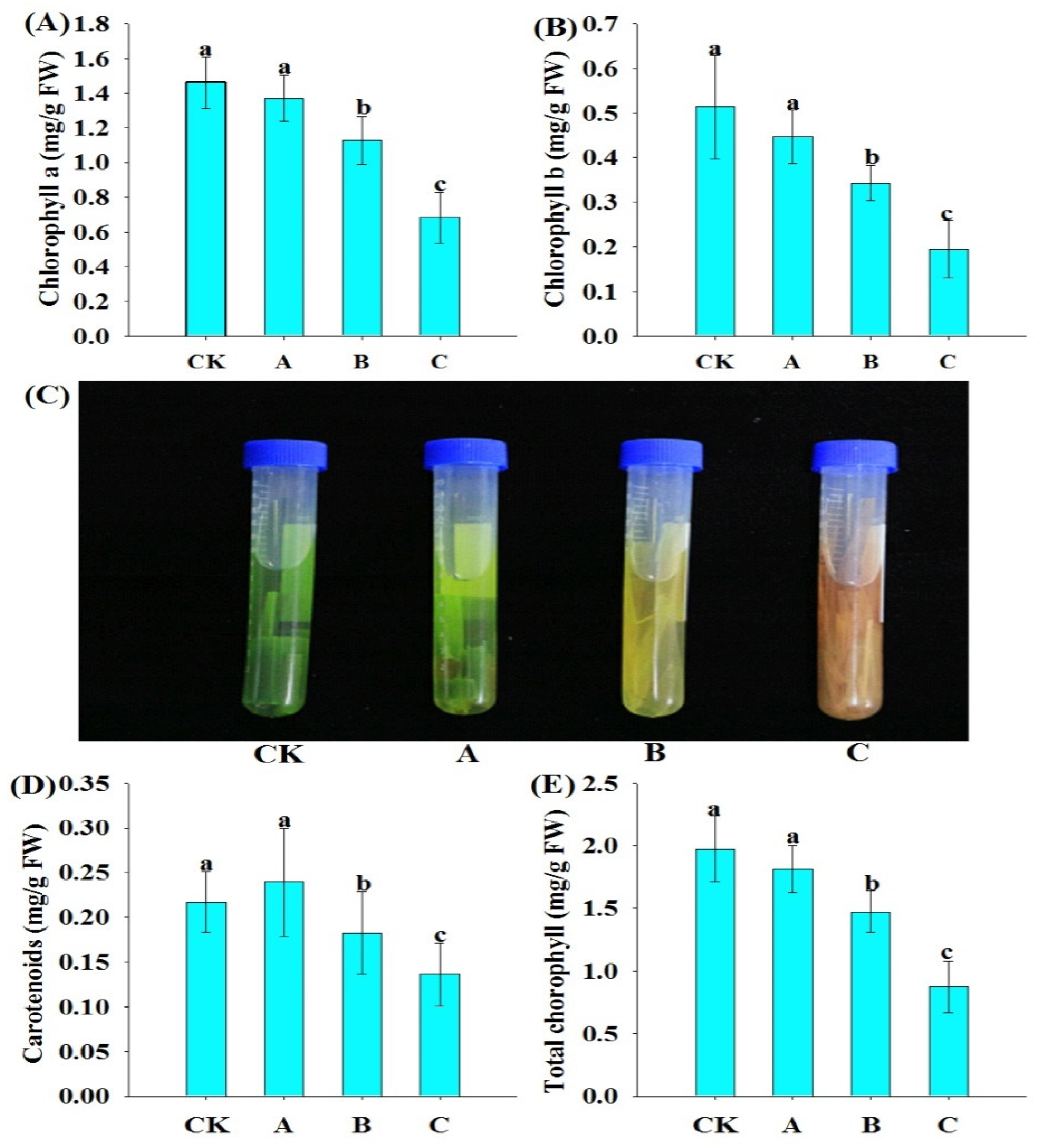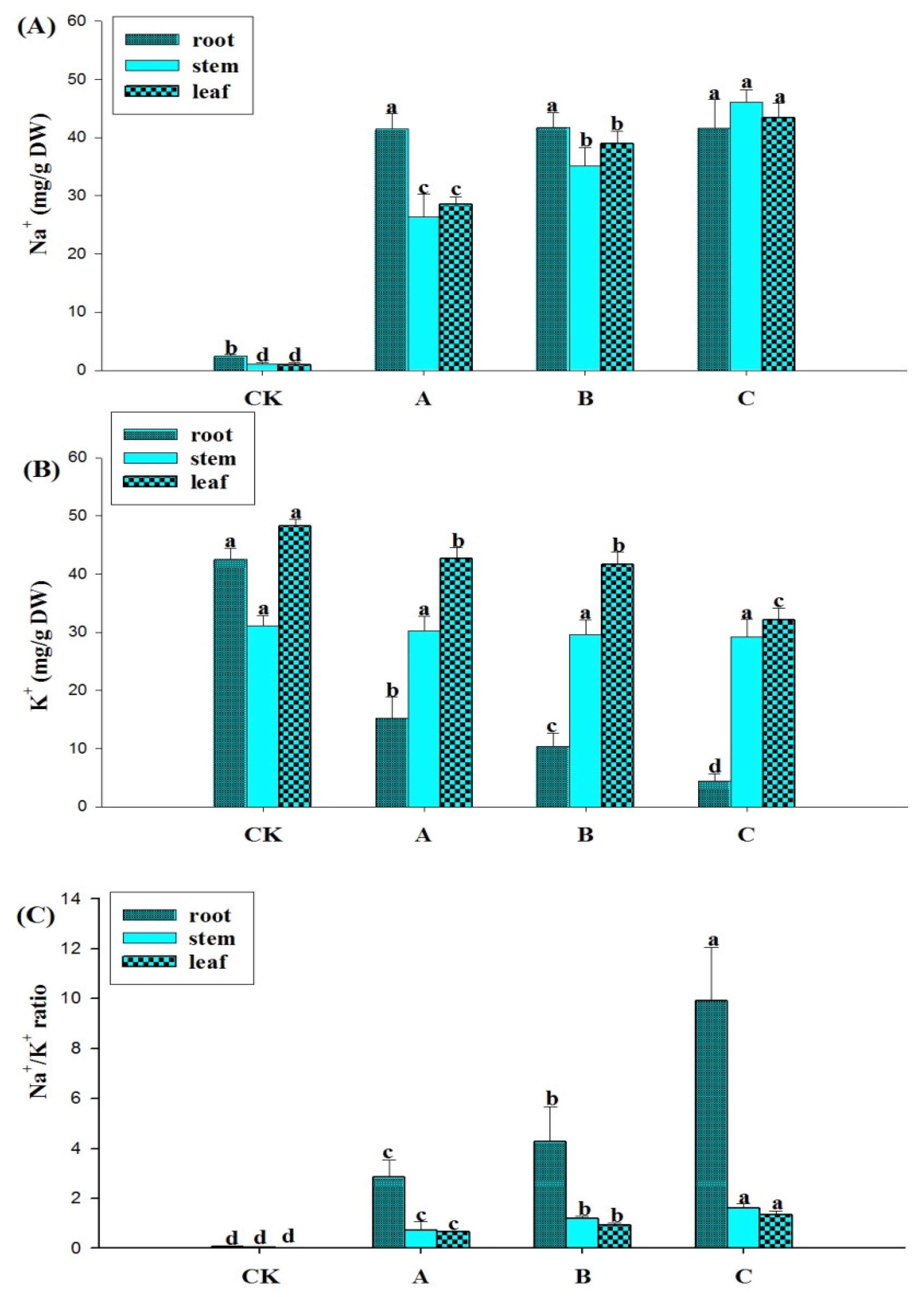Is High pH the Key Factor of Alkali Stress on Plant Growth and Physiology? A Case Study with Wheat (Triticum aestivum L.) Seedlings
Abstract
:1. Introduction
2. Materials and Methods
2.1. Plant Material and Experimental Design
2.2. Determination of Seedling Growth
2.3. Determination of Photosynthetic Pigment Content
2.4. Gas Exchange Characteristics
2.5. Determination of Antioxidant Enzyme Activities
2.6. Determination of Lipid Peroxidation
2.7. Determination of Membrane Injury (MI)
2.8. Determination of Proline and Soluble Sugar Contents
2.9. Statistical Analysis
3. Results
3.1. Plant Growth of Wheat Seedlings under Salt-Alkaline Stress
3.2. Chlorophyll Content of Wheat Seedlings under Salt-Alkaline Stress
3.3. Gas Exchange of Wheat Seedlings under Salt-Alkaline Stress
3.4. Ion Content of Wheat Seedlings under Salt-Alkaline Stress
3.5. Osmotic Substance of Wheat Seedlings under Salt-Alkaline Stress
3.6. Oxidation Resistance System of Wheat Seedlings under Salt-Alkaline Stress
4. Discussion
5. Conclusions
Author Contributions
Funding
Data Availability Statement
Conflicts of Interest
References
- Neumann, P. Salinity resistance and plant growth revisited. Plant Cell Environ. 1997, 20, 1193–1198. [Google Scholar] [CrossRef]
- Yu, S.; Yu, L.; Hou, Y. Contrasting Effects of NaCl and NaHCO3 Stresses on Seed Germination, Seedling Growth, Photosynthesis, and Osmoregulators of the Common Bean (Phaseolus vulgaris L.). Agronomy 2019, 9, 409. [Google Scholar] [CrossRef] [Green Version]
- Shahbaz, M.; Ashraf, M. Improving Salinity Tolerance in Cereals. Crit Rev Plant Sci. 2013, 32, 237–249. [Google Scholar] [CrossRef]
- Shi, D.; Wang, D. Effects of various salt-alkaline mixed stresses on Aneurolepidium chinense (Trin.) Kitag. Plant Soil. 2005, 271, 15–26. [Google Scholar] [CrossRef]
- Guo, Y.; Liu, Y.; Zhang, Y. Effects of Exogenous Calcium on Adaptive Growth, Photosynthesis, Ion Homeostasis and Phenolics of Gleditsia sinensis Lam. Plants under Salt Stress. Agriculture 2021, 11, 978. [Google Scholar] [CrossRef]
- Yang, J.Y.; Zheng, W.; Tian, Y. Effects of various mixed salt-alkaline stresses on growth, photosynthesis, and photosynthetic pigment concentrations of Medicago ruthenica seedlings. Photosynthetica 2011, 49, 275–284. [Google Scholar] [CrossRef]
- Chen, W.; Feng, C.; Guo, W. Comparative effects of osmotic-, salt- and alkali stress on growth, photosynthesis, and osmotic adjustment of cotton plants. Photosynthetica 2011, 49, 417. [Google Scholar] [CrossRef]
- Munns, R. Genes and salt tolerance: Bringing them together. New Phytol. New Phytol. 2005, 167, 645–663. [Google Scholar] [CrossRef]
- Gong, B.; Wen, D.; Bloszies, S. Comparative effects of NaCl and NaHCO3 stresses on respiratory metabolism, antioxidant system, nutritional status, and organic acid metabolism in tomato roots. Acta Physiol. Plant. 2014, 36, 2167–2181. [Google Scholar] [CrossRef]
- Xiaoyu, L.I.; Liu, J.; Zhang, Y. Physiological responses and adaptive strategies of wheat seedlings to salt and alkali stresses. Soil Sci. Plant Nutr. 2009, 55, 680–684. [Google Scholar]
- Assaha, D.V.; Ueda, A.; Saneoka, H.; Al-Yahyai, R.; Yaish, M.W. The Role of Na+ and K+ Transporters in Salt Stress Adaptation in Glycophytes. Front. Physiol. 2017, 8, 509. [Google Scholar] [CrossRef] [PubMed]
- Pivovarov, A.S.; Calahorro, F.; Walker, R.J. Na+/K+-pump and neurotransmitter membrane receptors. Invertebr. Neurosci. 2018, 19, 1. [Google Scholar] [CrossRef] [PubMed]
- Song, T.; Sun, N.; Dong, L. Enhanced alkali tolerance of rhizobia-inoculated alfalfa correlates with altered proteins and metabolic processes as well as decreased oxidative damage. Plant Physiol. Biochem. 2021, 159, 301–311. [Google Scholar] [CrossRef] [PubMed]
- Mittler, R.; Vanderauwera, S.; Gollery, M. Reactive oxygen gene network of plants. Trends Plant Sci. 2004, 9, 490–498. [Google Scholar] [CrossRef]
- Sun, Y.; Ou, Y.; Gao, Y. Different tolerance mechanism to alkaline stresses between Populus bolleana and its desert relative Populus euphratica. Plant Soil 2018, 426, 349–363. [Google Scholar] [CrossRef]
- Bing-Sheng, L.; Xiao-Wei, L.; Hong-Yuan, M. Differences in Growth and Physiology of Rice in Response to Different Saline-Alkaline Stress Factors. Agron. J. 2013, 105, 1889. [Google Scholar]
- Gong, B.; Wen, D.; Vandenlangenberg, K. Comparative effects of NaCl and NaHCO3 stress on photosynthetic parameters, nutrient metabolism, and the antioxidant system in tomato leaves. Sci. Hortic. 2013, 157, 1–12. [Google Scholar] [CrossRef]
- Liu, J.; Guo, W.Q.; Shi, D.C. Seed germination, seedling survival, and physiological response of sunflowers under saline and alkaline conditions. Photosynthetica 2010, 48, 278–286. [Google Scholar] [CrossRef]
- Hajihashemi, S.; Kazemi, S. The potential of foliar application of nano-chitosan-encapsulated nano-silicon donor in amelioration the adverse effect of salinity in the wheat plant. BMC Plant Biol. 2022, 22, 148. [Google Scholar] [CrossRef]
- Kadam, P.M.; Prajapati, D.; Kumaraswamy, R.V. Physio-biochemical responses of wheat plant towards salicylic acid-chitosan nanoparticles. Plant Physiol. Biochem. 2021, 162, 699–705. [Google Scholar] [CrossRef]
- Chaves, M.S.; Martinelli, J.A.; Wesp-Guterres, C. The importance for food security of maintaining rust resistance in wheat. Food Secur. 2013, 5, 157–176. [Google Scholar] [CrossRef] [Green Version]
- Becker-Reshef, I.; Justice, C.; Barker, B. Strengthening agricultural decisions in countries at risk of food insecurity: The GEOGLAM Crop Monitor for Early Warning. Remote Sens. Environ. 2020, 237, 111553. [Google Scholar] [CrossRef]
- Xiaoyu, L.; Xiaoyuan, P.; Zhixin, D. Biomass, Gas Exchange and Chlorophyll Fluorescence in Wheat Seedlings under Salt and Alkali Stress. Int. J. Agric. Biol. 2020, 23, 751–756. [Google Scholar]
- García-Mata, C.; Lamattina, L. Nitric Oxide Induces Stomatal Closure and Enhances the Adaptive Plant Responses against Drought Stress. Plant Physiol. 2001, 126, 1196–1204. [Google Scholar] [CrossRef] [Green Version]
- Wang, J.; Xie, H.; Han, J. Effect of graphene oxide-glyphosate nanocomposite on wheat and rape seedlings: Growth, photosynthesis performance, and oxidative stress response. Environ. Technol. Innov. 2022, 27, 102527. [Google Scholar] [CrossRef]
- Tian, T.; Wang, J.; Wang, H. Nitrogen application alleviates salt stress by enhancing osmotic balance, ROS scavenging, and photosynthesis of rapeseed seedlings (Brassica napus). Plant Signal. Behav. 2022, 17, 2081419. [Google Scholar] [CrossRef] [PubMed]
- Nakano, Y. Hydrogen peroxide is scavenged by ascorbate specific peroxidase in spinach chloroplasts. Photochem. Photobiol. 1981, 22, 867–880. [Google Scholar]
- Wei, Y.; Chen, H.; Wang, L. Cold acclimation alleviates cold stress-induced PSII inhibition and oxidative damage in tobacco leaves. Plant Signal. Behav. 2021, 17, 2013638. [Google Scholar] [CrossRef]
- Tantau, H.; Dörffling, K. In vitro-selection of hydroxyproline-resistant cell lines of wheat (Triticum aestivum): Accumulation of proline, decrease in osmotic potential, and increase in frost tolerance. Physiol. Plantarum. 2010, 82, 243–248. [Google Scholar] [CrossRef]
- Badem, A.; Söylemez, S. Effects of nitric oxide and silicon application on growth and productivity of pepper under salinity stress. J. King Saud Univ.-Sci. 2022, 34, 102189. [Google Scholar] [CrossRef]
- Buysse, J.; Merckx, R. An Improved Colorimetric Method to Quantify Sugar Content of Plant Tissue. J. Exp. Bot. 1993, 44, 1627–1629. [Google Scholar] [CrossRef]
- Fatima, A.; Hussain, S.; Hussain, S. Differential Morphophysiological, Biochemical, and Molecular Responses of Maize Hybrids to Salinity and Alkalinity Stresses. Agronomy 2021, 11, 1150. [Google Scholar] [CrossRef]
- Yang, C.W.; Xu, H.H.; Wang, L.L. Comparative effects of salt-stress and alkali-stress on the growth, photosynthesis, solute accumulation, and ion balance of barley plants. Photosynthetica 2009, 47, 79–86. [Google Scholar] [CrossRef]
- Shi, D.; Sheng, Y. Effect of various salt–alkaline mixed stress conditions on sunflower seedlings and analysis of their stress factors. Environ. Exp. Bot. 2005, 54, 8–21. [Google Scholar] [CrossRef]
- Hu, T.; Li, H.; Zhang, X. Toxic effect of NaCl on ion metabolism, antioxidative enzymes and gene expression of perennial ryegrass. Ecotox. Environ. Safe. 2011, 74, 2050–2056. [Google Scholar] [CrossRef] [PubMed]
- Chen, W.; Cui, P.; Sun, H. Comparative effects of salt and alkali stresses on organic acid accumulation and ionic balance of seabuckthorn (Hippophae rhamnoides L.). Ind. Crop Prod. 2009, 30, 351–358. [Google Scholar] [CrossRef]
- Wang, Y.; Chen, X.; Li, X. Exogenous application of 5-aminolevulinic acid alleviated damage to wheat chloroplast ultrastructure under drought stress by transcriptionally regulating genes correlated with photosynthesis and chlorophyll biosynthesis. Acta Physiol. Plant 2021, 44, 12. [Google Scholar] [CrossRef]
- An, Y.; Gao, Y.; Tong, S. Morphological and Physiological Traits Related to the Response and Adaption of Bolboschoenus planiculmis Seedlings Grown Under Salt-Alkaline Stress Conditions. Front. Plant Sci. 2021, 12, 567782. [Google Scholar] [CrossRef]
- Blumwald, E. Sodium transport and salt tolerance in plants. Curr. Opin. Cell Biol. 2000, 12, 431–434. [Google Scholar] [CrossRef]
- Wang, X.S.; Han, J.G. Effects of NaCl and silicon on ion distribution in the roots, shoots and leaves of two alfalfa cultivars with different salt tolerance. Soil Sci. Plant Nutr. 2007, 53, 278–285. [Google Scholar] [CrossRef]
- Munns, R.; Tester, M. Mechanisms of Salinity Tolerance. Annu. Rev. Plant Biol. 2008, 59, 651–681. [Google Scholar] [CrossRef] [PubMed] [Green Version]
- Karuppanapandian, T.; Moon, J.C.; Kim, C. Reactive oxygen species in plants: Their generation, signal transduction, and scavenging mechanisms. Aust. J. Crop Sci. 2011, 5, 709–725. [Google Scholar]
- Lu, S.; Zhang, S.; Xu, X. Effect of increased alkalinity on Na+ and K+ contents, lipid peroxidation and antioxidative enzymes in two populations of Populus cathayana. Biol. Plantarum. 2009, 53, 597. [Google Scholar] [CrossRef]






Publisher’s Note: MDPI stays neutral with regard to jurisdictional claims in published maps and institutional affiliations. |
© 2022 by the authors. Licensee MDPI, Basel, Switzerland. This article is an open access article distributed under the terms and conditions of the Creative Commons Attribution (CC BY) license (https://creativecommons.org/licenses/by/4.0/).
Share and Cite
Liu, D.; Ma, Y.; Rui, M.; Lv, X.; Chen, R.; Chen, X.; Wang, Y. Is High pH the Key Factor of Alkali Stress on Plant Growth and Physiology? A Case Study with Wheat (Triticum aestivum L.) Seedlings. Agronomy 2022, 12, 1820. https://doi.org/10.3390/agronomy12081820
Liu D, Ma Y, Rui M, Lv X, Chen R, Chen X, Wang Y. Is High pH the Key Factor of Alkali Stress on Plant Growth and Physiology? A Case Study with Wheat (Triticum aestivum L.) Seedlings. Agronomy. 2022; 12(8):1820. https://doi.org/10.3390/agronomy12081820
Chicago/Turabian StyleLiu, Duo, Yue Ma, Mengmeng Rui, Xiachen Lv, Rongjia Chen, Xiaoyan Chen, and Yizhou Wang. 2022. "Is High pH the Key Factor of Alkali Stress on Plant Growth and Physiology? A Case Study with Wheat (Triticum aestivum L.) Seedlings" Agronomy 12, no. 8: 1820. https://doi.org/10.3390/agronomy12081820
APA StyleLiu, D., Ma, Y., Rui, M., Lv, X., Chen, R., Chen, X., & Wang, Y. (2022). Is High pH the Key Factor of Alkali Stress on Plant Growth and Physiology? A Case Study with Wheat (Triticum aestivum L.) Seedlings. Agronomy, 12(8), 1820. https://doi.org/10.3390/agronomy12081820






